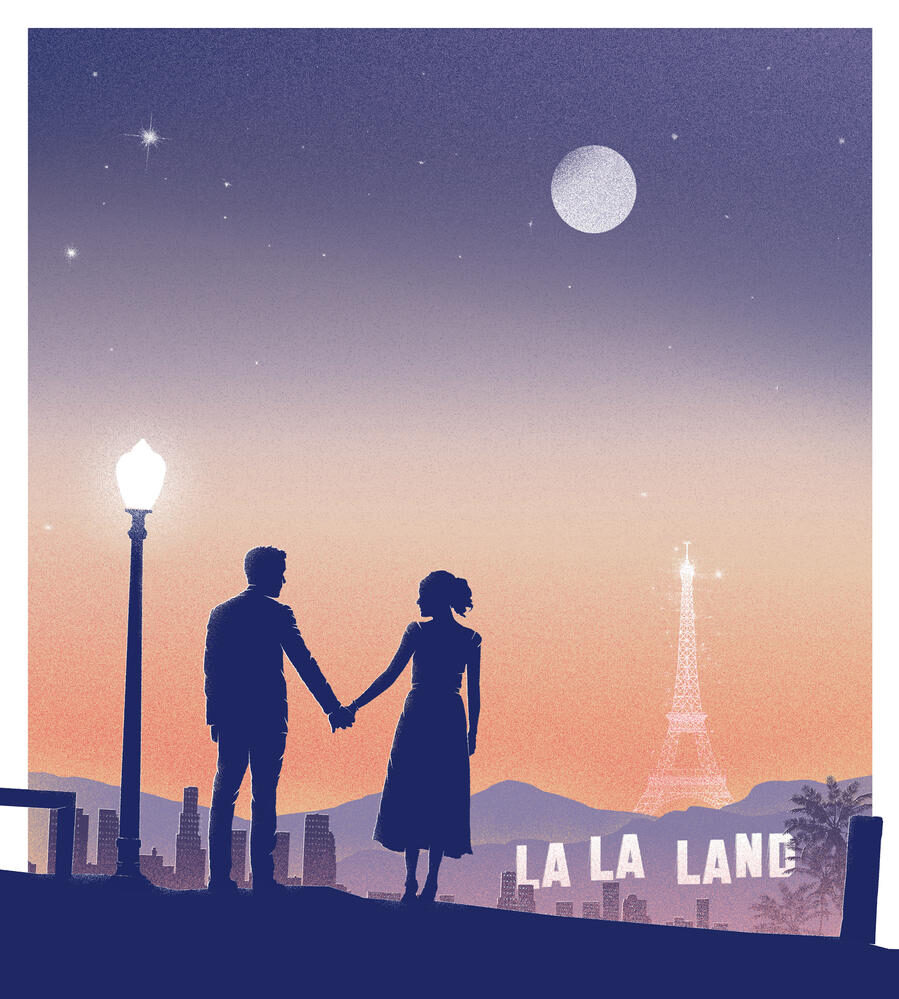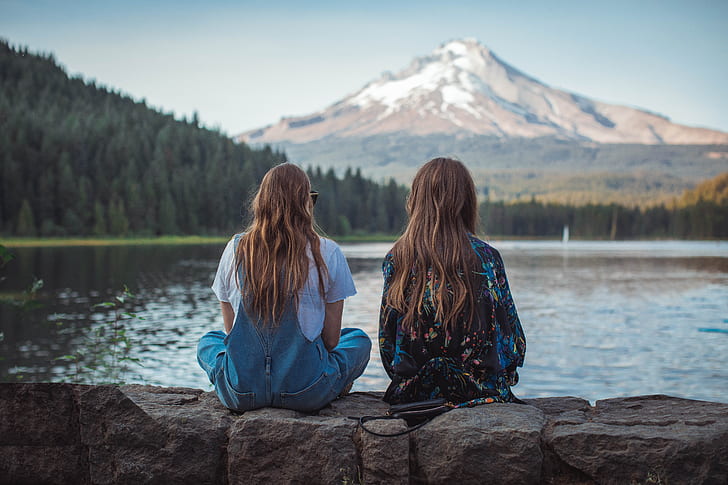A Visual Symphony of Emotion
La La Land is more than just a musical; it’s a visually stunning journey where every frame is a burst of color, music, and emotion. Directed by Damien Chazelle, the film uses a vibrant color palette to not only dazzle but to tell a deeper story. Through careful color choices, Chazelle enhances the emotional depth of the characters, particularly Mia (Emma Stone) and Sebastian (Ryan Gosling), as they navigate their dreams, passions, and heartbreak.
Color becomes a powerful storytelling tool, reflecting the highs and lows of the characters’ inner worlds. From the dreamy blues and purples that symbolize their aspirations to the fiery golds and yellows that capture the intensity of their romance, every hue in La La Land serves a purpose. This article will explore how Chazelle uses color to narrate a love story that is both nostalgic and modern, creating an unforgettable cinematic experience.
The Color of Dreams: Blue and Purple as Symbols of Aspiration
Blue and purple dominate many of the key moments in La La Land, representing the characters’ dreams, ambitions, and a sense of wonder. These colors serve as a visual metaphor for the idealism that Mia and Sebastian pursue in their personal and professional lives. Blue, often associated with introspection and longing, appears frequently, especially in scenes where the characters are reflecting on their desires and struggles.
One standout example is the scene “A Lovely Night,” where Mia and Sebastian dance under the twilight sky, bathed in shades of deep blue and purple. This not only reflects their shared aspirations but also the fleeting, dreamlike quality of the connection they are beginning to form. Similarly, in the song “City of Stars,” the use of these colors deepens the melancholic mood, symbolizing the beauty and struggle of chasing one’s dreams in a city full of them.
These colors help viewers feel the tension between idealism and reality, reminding us that dreams are both beautiful and fragile. They visually capture the sense of longing, not just for love, but for success and fulfillment in the creative world.
Yellow and Gold: Passion, Joy, and the Spark of Romance
As Mia and Sebastian’s relationship blossoms, the film’s color palette shifts to include vibrant shades of yellow and gold, symbolizing the warmth, passion, and joy of their romance. These colors burst onto the screen in moments of connection and happiness, serving as a visual cue for the audience that love is in full bloom.
One striking example of yellow’s significance is during the “Epilogue” sequence, where golden hues light up a fantasy version of the life they could have had together. The color symbolizes the fleeting beauty of their romance—full of joy, passion, but ultimately transient. Throughout their relationship, yellow becomes a recurring motif in their happiest moments, such as their dates at jazz clubs or intimate dinners at home, reflecting the glow of love.
Gold, on the other hand, represents the success they both crave, but also the moments when that success pulls them apart. The balance between yellow and gold throughout the film shows how closely love and ambition are intertwined for the couple. In a way, the colors also foreshadow the bittersweet nature of their relationship—golden moments are powerful but not everlasting. Just as quickly as the bright hues of happiness appear, they fade, leaving behind the complex emotions that come with love, success, and sacrifice.
The Shift to Red: Conflict and Tension
As La La Land progresses, the color palette shifts toward deeper, more intense hues of red, marking moments of conflict, tension, and emotional distance between Mia and Sebastian. Red, traditionally associated with passion, here takes on a dual meaning—it embodies the intensity of their love but also the growing strain in their relationship as their personal dreams start to pull them apart.
This transition becomes evident during the climactic moments of the film, particularly when Mia and Sebastian have a heated argument. The once vibrant and whimsical color palette darkens, with red seeping into their surroundings, symbolizing the emotional turmoil they both feel. The warm glow of red in earlier romantic scenes now appears harsher, signaling the growing distance between them.
This shift in color emphasizes the characters’ internal struggles as they grapple with balancing their love for each other and their ambitions. The use of red creates a visual metaphor for the tension in their relationship, foreshadowing the eventual dissolution of their romantic bond as they prioritize their individual dreams.
Green and Blue: Symbolizing Choice and Transition
Green and blue play crucial roles in La La Land during moments of significant choice and transition. These colors, often associated with growth and transformation, reflect the characters’ internal shifts as they navigate pivotal life decisions. Green, in particular, is prominently used during Mia’s final audition scene, where the hue fills the room, symbolizing the crossroads she finds herself at—choosing between her love for Sebastian or fully pursuing her acting career.
The green tones in this scene subtly signal a rebirth of Mia’s ambitions, as she steps into the spotlight and embraces the possibility of her career taking off. Meanwhile, blue, often representing introspection and emotional depth, is woven into moments of reflection and realization. For instance, when Sebastian contemplates his future at the jazz club, the use of blue conveys a sense of longing and self-discovery, as he faces the reality of his path.
These shifts in color mirror the characters’ emotional journeys, providing visual cues for the audience to track their growth and transitions. By the end of the film, green and blue symbolize the choices that Mia and Sebastian must make, signaling that their paths will diverge in pursuit of their individual dreams.
The Epilogue: A Kaleidoscope of Color and What Could Have Been
The epilogue of La La Land is a vivid, dreamlike sequence where color plays a central role in illustrating the “what if” fantasy of Mia and Sebastian’s relationship. Here, a kaleidoscope of bold, contrasting colors, including gold, red, blue, and green, sweeps through the imaginary montage of a life they could have had together. The vibrant hues are a stark contrast to the more muted tones of reality, representing the idealized, perfect version of their relationship—one filled with happiness, love, and unachieved possibilities.
This sequence revisits all the major color themes from earlier in the film, blending them together to create a sense of nostalgia and bittersweet longing. The use of gold and yellow emphasizes the joy and beauty of their “perfect” life, while the deeper reds and blues hint at the passion and emotional complexities they experienced. The constant shifts in color highlight the emotional highs and lows of this alternate reality, creating a visual representation of both the beauty and the sorrow of love lost.
Ultimately, the epilogue serves as a reminder of the paths not taken, where the kaleidoscope of color reflects the intricate, multi-faceted nature of relationships, dreams, and the choices that define our lives.
Color as a Storytelling Tool in La La Land
Throughout La La Land, color isn’t just an aesthetic choice; it’s a vital storytelling tool that enhances the emotional narrative of Sebastian and Mia’s relationship. From the dreamy blues that capture their aspirations to the fiery reds that signify tension and conflict, every hue serves to deepen the audience’s understanding of the characters’ internal struggles and emotional journeys.
The film stands as a modern example of how color can elevate storytelling, creating a visual language that communicates far more than dialogue or plot alone. La La Land’s legacy as a visual masterpiece endures, with its thoughtful use of color continuing to inspire filmmakers and audiences alike. It’s a testament to how color, when used deliberately, can transcend mere aesthetics and become a narrative force of its own.



